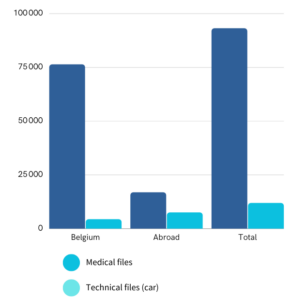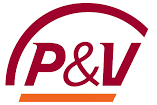The artificial intelligence breakthrough in the insurance sector
According to the International Data Corporation, the spending on artificial intelligence will surpass $300 billion in 2026. According to McKinsey, the use of AI will boost productivity and reduce operating costs by 40% by 2030.
Whilst the use of artificial intelligence technologies offers many advantages for insurance companies, the risks associated with them are equally significant, and managing them is essential to ensure that AI is used to best effect and becomes a major breakthrough.
Benefits of artificial intelligence
Pricing and reserving
Thanks to its ability to gather and process a large amount of data, artificial intelligence and its developments are helping to improve pricing methods.
With the implementation of Machine Learning in the insurance industry, the accuracy of data processing used to determine insurance policies has been enhanced, by collecting a vast amount of data, both internal and external, and automating its processing. This tool is already widely used for pricing non-life insurance products and is nothing new to the sector.
The development of AI does, however, give insurers access to data from multiple sources. As a result, the pricing and development of new tailor-made insurance products, or even micro-coverages adapted to specific needs, are positive aspects of the advance of AI in the sector. By using a wide range of data, individual risk can be better predicted and policies can be more accurately priced by increasing the number of parameters taken into account in the models. These insurances, particularly in the car sector, will adapt to the behaviour and activities of policyholders thanks to more detailed data analysis, for example through behavioural dynamic modelling.
Artificial intelligence will connect the insurer and the policyholder in real-time, resulting in the development of a new business model: insurance policies priced, purchased and linked in real-time.
In addition, the development of artificial intelligence techniques also helps to better study the development of portfolio claims, thereby identifying and modelling claims that develop over a longer period and have an impact on the reserving strategy. These techniques can also be used to determine which claims will cost the most quickly. These advances mean that the models used are increasingly accurate, since they take into account the characteristics of claims, resulting in better modelling of the severity component of pricing because the projection of future amounts to be paid is more precise.
Prediction and claims management
In addition to underwriting, the AI breakthrough can significantly contribute to claims prediction and management.
The Machine Learning models developed for claims volume forecasting are already implemented in the current methodology. However, the use of AI could allow almost complete automation of the management process. Indeed, claims analysis could be accelerated, particularly in car insurance, using Deep Learning and damage processing based on images from a smartphone or visual recognition, in addition to the insurer’s historical data.
The algorithms powered by this data can be used to predict and prevent claims, since they will be optimised to detect which policyholders are likely to make a claim and forecast events which could cause claims to be made.
Moreover, AI would facilitate rapid and instant processing of claims handling, compensation and reporting. This would reduce the financial burden on insurance companies and boost customer satisfaction and retention. A concrete example is the case of the American insurtech Lemonade, which is believed to have made the fastest claim settlement in history: in 3 seconds.
Combining artificial intelligence with the volume of data available to insurers could also improve the assessment of other damages at different levels. More specifically, the amount of compensation and the degree of disability for certain types of injury or, on the contrary, the analysis of the reasons for rejecting a claim under health or disability insurance could be simplified.
“AI would facilitate rapid and instant processing of claims handling, compensation and reporting.”
Fraud dectection
The use of AI to detect insurance fraud is an increasingly common practice in the industry. Indeed, one very specific case involves the analysis of claims using sophisticated algorithms to identify potential fraud.
These algorithms can investigate trends and abnormal patterns to detect fraudulent behaviour. These tools include text analysis, which identifies contradictory or inconsistent information in claims. Image analysis identifies changes made to pictures sent to the insurance company to show the damage when a claim is opened. Finally, behavioural pattern analysis can identify unusual or suspicious customer behaviour and can even detect abnormal behaviour from distribution networks.
However, the use of AI to detect insurance fraud raises major issues, such as biased or incomplete data, which can lead to errors in detection, and the issue of confidentiality and protection of customer data. These problems are still being studied in the academic world and improvements are being made.
Its limits for the sector and the actuarial profession
In spite of the non-exhaustive list of benefits described above, the use of artificial intelligence in the sector raises fears and entails risks that we need to be aware of and prepared for.
Compliance and ethical issues
In particular, the use of generative technologies raises compliance and ethical issues, as some of them are based on probabilistic models that are not designed to comply with strict policies. In addition, these technologies collect data to continually refine themselves, which makes it difficult to remove data and information from their knowledge base.
“It is therefore necessary to take the time to understand these systems, which are very often described as “black boxes”. Openng these “black boxes” is possible, but this requires the appropriate specific skills.”
Furthermore, because these technologies predict relevant responses based on observation and replication of what they have been trained on, they can be biased, which can be difficult and costly to correct for the user who is not prepared to deal with this bias. Indeed, in order to detect these biases, it would be necessary to carry out tests to identify these defects in the data set.
However, the use of AI and its consequences are subject to the programmer or user behind the technology, who may also be biased. It is therefore necessary to take the time to understand these systems, which are very often described as “black boxes”. Opening these “black boxes” is possible, but this requires the appropriate specific skills.
The actuarial intuition
When it comes to actuarial intuition, artificial intelligence will not be able to act as a substitute for all the risks impacting the market. In particular, there are special risks (earthquakes, political risks, etc.) for which little historical data exists and which will always require the expertise of the actuary. In these cases, assessing the risk depends not only on the estimate of the final loss, but also on other factors, such as the buy-back of reinsurance or the company’s solvency requirements, which AI cannot take into account at this stage.
However, AI can in some cases provide new insights to help actuaries make the right decisions. The combination of AI and intuition is therefore key and can be a major help for the actuarial profession.
The interpretation of results
Beyond these special risks, interpreting the results generated by Deep Learning and Machine Learning models involves a different kind of thinking that implies a knowledge of the business approach that only an actuary familiar with the business can have. Actuaries have the power to contextualize results and explain what they mean by establishing a link with the company’s business and how these results feed into other results.
The sector’s adaptation to the use of artificial intelligence
Artificial intelligence and its many developments are not unknown to the market. Indeed, insurtechs have been pioneers in the use of artificial intelligence since their emergence in the mid-2010s. Over the last few years, insurtechs have become increasingly prominent in the sector because they are prepared to change traditional methods by adopting AI. In particular, Capgemini identifies three types of insurtech in the market: full carriers, which develop new innovative insurance products and distribute them (Alan, Luko, Qover), distributors, and enablers such as Akur8, which provide technological solutions to traditional insurance companies. Insurers will evolve with this changing environment by working more closely with these insurtechs as part of a wider ecosystem and fulfilling new roles within it as directors and providers of “active” insurance products.
In terms of European regulations, the European Union is currently considering a draft regulation known as the AI Act, which would come into force by 2025. Indeed, the law contains an initial requirement for the documentation and assessment of artificial intelligence applications, particularly in the case of life and health insurance, which are defined by the EU as high-risk cases. However, the introduction of the AI Act will have an impact on actuaries and their work. In the future, when selecting statistical models for calculating underwriting risks, classification according to the AI Act will also have to be taken into account and documented.
Broadly speaking, the development of AI is leading to a transformation of the actuarial profession and a move towards hybrid processes. Showing interest in new technologies and new languages (R, Python) are skills that are increasingly sought after in the profession, and this is not surprising as actuaries will always have a key role in analysing data and interpreting it, all in an environment subject to strict regulatory constraints. Actuaries will also have a key role in persuading management of the relevance of the models used and the results produced. This development will also require greater collaboration between traditional actuarial profiles and data science-oriented profiles.
“The development of AI is leading to a transformation of the actuarial profession and a move towards hybrid processes.”
Therefore, the fear of a decrease in demand for actuarial profiles is not yet likely. Actuaries will continue to be crucial to the development of AI within insurance companies. They will be essential in assessing risk, using statistical models to inform the development of AI, validating model, assessing the fairness and accuracy of AI algorithms, and ensuring that AI systems comply with regulations and that they are used ethically. As AI develops, actuaries will be able to develop by adopting the fundamentals of data science, a skill increasingly sought after by insurance companies.
Conclusion
As discussed above, the development of artificial intelligence and its specific features can bring considerable benefits in an increasingly competitive market. All in all, it allows insurers to reduce costs in a number of areas and to be more competitive in the market by offering products that are aligned with policyholders’ needs.
Artificial intelligence is currently transforming the actuarial profession. Consequently, adapting to these technologies and understanding their impact on improving the profession is a challenge that actuaries are facing and will continue to face in the coming months.
Finally, an advantage that we might not think of when we talk about AI is that it will enable us to focus more on the human aspect. Thanks to the automation of calculation and administrative tasks, actuaries will have more time to devote to higher added-value activities, to which artificial intelligence will provide new information that will help the actuary to make decisions.
Sources:
- Insurance Europe, AI in the insurance sector
- McKinsey, Insurance 2030 – The impact of AI on the future of insurance
- Dataconomy, The insurance of insurers
- Mostly AI, AI and machine learning use cases for insurance 2023
- KPMG, Powering insurance with AI
- LinkedIn, How Can ChatGPT Be Used in Insurance?
- Institut des Actuaires, Intelligence Artificielle: vers une mutation des métiers
- Forbes, L’intelligence artificielle et le métier d’actuaire 4.0
- Millenaire 3, Actuariat et intelligence artificielle : l’exemple d’addactis
- The European Actuary
- ProActuary, Will Artificial Intelligence Replace Actuaries?
- Numalis, L’IA dans la finance, les banques et assurances, en vaut-elle l’investissement malgré les défis ?
- L’Echo, L’intelligence artificielle s’immisce dans vos tarifs d’assurance
- ProActuary, AI for Actuaries : What do you need to know?
- ACPR, La transformation numérique dans le secteur français de l’assurance
- Aaa-risk finance, AI : Actuarial Intelligence












































































 The famous financial rating agency Fitch gives Ethias an IFS “A” rating. The “A” score demonstrates the solid financial situation of Ethias and its strong market position given the current economic environment.
The famous financial rating agency Fitch gives Ethias an IFS “A” rating. The “A” score demonstrates the solid financial situation of Ethias and its strong market position given the current economic environment.










































































